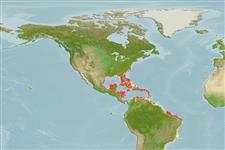Preferred temperature (Ref.
115969): 23.2 - 28, mean 26.8 (based on 420 cells).
Fylogenetische diversiteitsindex (Ref.
82804): PD
50 = 0.5000 [Uniqueness, from 0.5 = low to 2.0 = high].
Bayesian length-weight: a=0.01585 (0.01287 - 0.01951), b=2.94 (2.91 - 2.97), in cm Total Length, based on LWR estimates for this species (Ref.
93245).
Trofisch niveau (Ref.
69278): 4.3 ±0.1 se; based on diet studies.
Weerstandsvermogen (Ref.
120179): Gemiddeld, minimale populatieverdubbelingstijd 1,4-4,4 jaar (K=0.14-0.24; tm=3; Fec=800,000).
Fishing Vulnerability (Ref.
59153): High vulnerability (57 of 100).
Climate Vulnerability (Ref.
125649): Very high vulnerability (84 of 100).
